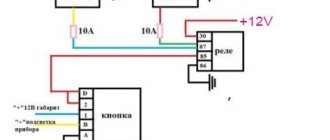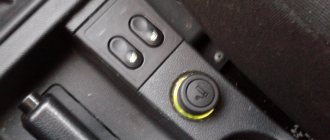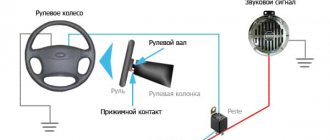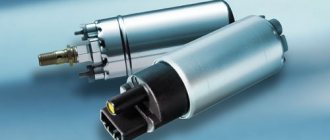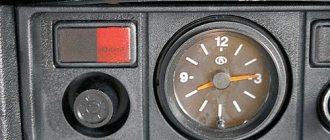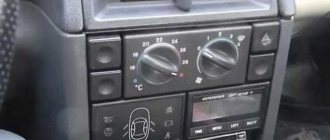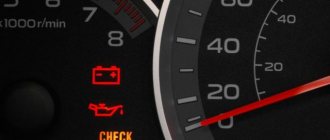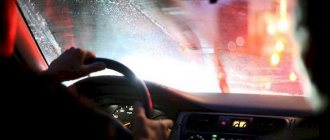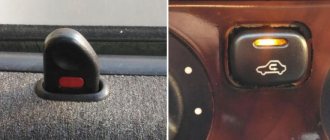04/27/2021 4,653 Light and sound devices
Author: Ivan Baranov
Turning lights are an integral element of optics in any modern car. Their purpose is to warn other road users that the driver is planning to make a maneuver. For what reasons do turn signals and emergency lights not work, how to check the functionality of optical elements and how to repair them. We will talk about this below.
[Hide]
Turn signals and emergency lights of VAZ 2114 do not work: what to do?
Emergency stop and turn signals are one of the most important signaling and lighting devices in a car. They are necessary for safe movement on the road and coordination of motorists with each other. If it happens that the turn signals and emergency lights of the VAZ 2114 do not work, then you cannot continue driving the car (until the breakdown is fixed).
Below we will analyze the main reasons for the malfunction of the light alarm in a car, and also tell you how to eliminate them.
Emergency signal malfunctions
[flat_ab id=”3"]
If the VAZ 2114 emergency light does not work, then troubleshooting should begin with the fuse box. To do this, you need to check and, if necessary, replace with a new one, 10 Amp fuse F2. Simultaneously with checking the fuse, you should inspect and clean the contacts in the mounting socket of the common unit (if they are oxidized, the emergency light may not work even with a working fuse).
VAZ 2114 fuse box
The next step in finding a breakdown is to check the presence of voltage at contact X2/5, which is located on the mounting block (this is done using a multimeter and with the emergency button turned on).
The lack of power will indicate a break in the wire that goes from this contact to the alarm button.
If the wiring turns out to be working, then you should check the emergency light bulb and, if it is burnt out, simply replace it with a new one (the new light bulb must be suitable in power - you should not install weaker or more powerful lamps). At the same time, the contacts in the cartridge should also be cleaned.
You can do this:
- fine sandpaper;
- kerosene;
- refined gasoline;
- VD-40.
If the light bulb, wires and fuse are in good working order, then you should make sure that the button itself is working. To do this, you need to turn on the button and ring it using a multimeter.
If the button turns out to be broken, it should be replaced with a new one, since this element is not repairable.
If a breakdown of the hazard warning button is discovered on the road, and the hazard warning light itself is urgently needed, then you can make do with “improvised means”. To do this, you need to dismantle the button, disconnect it from the block and connect the two sockets in the block using any metal wire, thereby closing the alarm circuit.
Another cause of failure may be the failure of relay K2. You can find out about this by indirect signs - if the relay is faulty, both the emergency lights and the turn signals will not work. In this case, the relay should be replaced with a new, similar one.
Turn signals don't turn on
Sometimes it happens that the turn signals of the VAZ 2114 do not work.
This may be expressed by the following signs:
- The turn signals do not turn on.
- The turn signals do not turn off.
- The turn signals don't blink.
- The turn signals light up with minimal brightness.
In the first case, there may be several reasons (they are almost the same as in the case of problems with emergency lights):
- fuse is blown;
- power buttons are broken;
- contacts have oxidized;
- there was a break in the wiring;
- the relay has failed;
- light bulbs burned out.
Checking the electrical system of turn signals in these situations, as well as eliminating detected problems, should be carried out in the same way as repairing emergency lights (how exactly is described above).
If the turn signals, on the contrary, do not turn off, then there can only be one reason - burnt out switches. They should be replaced with new ones of a similar model.
Sometimes the turn signals may turn on, but remain solid instead of blinking. The reason for this is the incorrect operation of the relay (sometimes this also happens when a device intended for other cars is installed instead of the original relay). To eliminate the cause, it is enough to replace the relay with a new one.
If the turn signals are on but not blinking, you can try gently knocking on the relay body - sometimes this can help, but the effect is usually short-lived.
In a situation where the turn signals are very dim, you should check the power of the lamps installed in them. If the lamps are suitable, then you need to clean the ground contact connected to the turn signals. This can be done with fine sandpaper or kerosene.
Source: https://VAZremont.com/ne-rabotayut-povorotniki-i-avariyka-vaz-2114
VAZ 2114 turn signals do not work. The turn signal flashes quickly. Determining the cause of this malfunction
Some breakdowns often happen to cars, both serious and trivial, but they all make the car owner nervous. One of the trivial faults is when the turn signal on a car flashes very quickly, and only on one side: either on the left or on the right. What this may signal, what reasons may precede the occurrence of this problem will be described further in our article.
Why is the turn signal flashing quickly?
Such a small nuisance can happen to anyone and, in most cases, there is nothing serious about it. For example, the most common reason that the turn signal blinks very quickly may be that one of the bulbs has burned out.
For example, if at least one turn signal bulb burns out - front, rear, or additional - this is quite enough for the current resistance in the network to change. The result is that the entire side where the bulb is faulty will blink very quickly.
You just need to screw in a new lamp and everything will be fine.
If the left or right turn signal blinks quickly, but all the lights are working, then the problem is of a different nature. Alternatively, it is possible that carbon deposits, rust, or dirt have formed on the lamp base and in the socket contact itself, making the contact unstable. This may well be the reason why the turn signal of the VAZ 2109, or any other car, is flashing quickly. To solve this problem, you will have to disassemble all the turn signals and clean all the lamps and contacts.
The turn signal on the VAZ 2107 flashes quickly much less often due to a faulty turn signal relay. As a rule, relays last for decades, so this reason can be considered an exception.
Finally, another reason that the turn signal blinks quickly is the installation of LED lamps rather than ordinary incandescent lamps. LED lamps have a completely different resistance, so their installation can also cause frequent blinking of the turn signal.
If all these options do not suit your case, if the light bulbs are new, the contacts are clean, the relay is working, the fuses are intact - you are out of luck, since the problem is in the wiring itself. If you are not an electrician, then you will not be able to deal with this trouble yourself - contact a car service center.
We hope that we were able to help you solve the problem of why the turn signal is blinking frequently. Read more of our articles, improve your knowledge, because car repair is easy.
I replaced the turn switch and it doesn't work well. I turn on the turn (right and left), it blinks once, 2 times there is sound, but without the turn signal blinking, on the 3rd and further there is no sound and no blinking. I took it apart and reinstalled it several times. The alarm works flawlessly and the fuses are also ok.
The power supply circuit for the VAZ 2114 turn signals includes a steering column switch, a relay, a fuse, an alarm switch, lamps and wiring.
Each of these elements performs its own function. The switch supplies power to the necessary lamps. Additionally, voltage can be supplied through the emergency button, bypassing the switch. To protect the wiring from a possible short circuit in the turn signal wiring, fuses are included in the circuit.
The relay is responsible for interrupting the lighting of the lamps, that is, this element ensures the blinking of the turn signals. In addition, it makes it possible to determine the serviceability of all lamps. If at least one lamp burns out, the blinking frequency of all turn signals, as well as the warning lamp on the dashboard, will double.
If, after replacing the steering column switch, problems arise with the operation of this light alarm, in this case the one-time operation of the lamps is to blame for this relay.
Everything is simple here - if the switch was faulty, then the turn signals either would not work at all, or they would work in one mode, for example, the right turn signals would blink, but the left ones would not.
The fuses also disappear, since if they blew, no power would be supplied to the circuit, that is, the turns would not work at all.
THIS IS INTERESTING: Replacing the Peugeot 206 thermostat
The relay is not an expensive part, so it is easier to replace it than to repair it.
Still, before replacing this component, it is recommended to first check its functionality. To do this, you can borrow this element from another car or install your relay on another car.
Replacement is easy. On the VAZ 2114 this element is located in the fuse box. Under the cover of this block there is a diagram of the location of all fuses and relays, using it you can easily find the necessary element.
If there is no diagram, then it is easy to determine what you need - it is located in the top row, second from the left. It does not have any fastening, it is simply installed with its plugs in the connectors.
It is worth noting that you must purchase and install on your car only a relay recommended by the manufacturer, in this case model 493.3747. It is also possible to install analogues, of which there are many on the market now, but first you should inquire about the operating parameters, which are usually marked on the body. The characteristics of the failed and purchased elements must completely match.
All that remains is to install a new element in the fuse box and check the functionality of the turn signals.
Turning lights should be in working order in any car. This type of optics allows other road users to know your intentions when making maneuvers, so the performance of turns has a large impact on safety. What to do if the VAZ 2114 emergency light does not work, how to identify the problem and replace the lamps? Read about it below.
Possible malfunctions: signs and causes
If you don’t know how, then there’s nothing complicated about it - you just need to close the contacts, but that’s not about that now.
What signs can be used to identify problems with turning lights (SW):
- Rotation turns on but doesn't work. A malfunction of such a plan may be caused by problems in the operation of the breaker relay.
Source: https://drauf.ru/vaz-2114-do-not-work-turn-signals-the-turn-signal-light-flashes-quickly/
Power fuses
The power fuse and relay block is located on the strip under the panel (dashboard), at the feet of the front passenger; to access you need to bend the plastic side panel.
Depending on the car model, the appearance of the unit may differ slightly from that shown in the photo.
The lowest relay and fuse are the fuel pump. When the ignition is turned on, the fuel pump turns on for 5 seconds to create pressure in the system. Check the ground and contacts of this unit, and also inspect the wiring. The wire from the relay to the pump, which runs along the floor under the casing, may be broken.
The topmost relay is the radiator cooling fan. If it is OK, see the information about fuse F5.
Mounting block connection diagram
Most serious electrical problems can be solved by replacing the fuse and relay mounting block. The price of such an assembled unit is about 1500-2000 rubles. Usually, due to oxidation of contacts, current surges, moisture ingress after washing, dust, dirt and other factors, printed circuit board tracks and contacts become green or black, and simply fail.
If your VAZ 2115 is several years old and nothing has been done to the block, then there is a very high probability of seeing all the problems described above when it is removed. Replacing the unit with a new one will avoid many future problems. The electrics will work as they should, most likely even better. There are often cases when, after replacement, devices that never worked before begin to work. Drivers get used to the car and do not know how it should be in fully working order.
Therefore, in case of serious problems, I advise you not to save money and change the unit. It would also be a good idea to replace the steering column switches - it will save a lot of nerves and time in the future, and it will just be a pleasure to drive a working car.
Another important point in case of electrical faults in the VAZ-2115 is the presence of good contact to the body. The block is grounded to the car body and uses it as a second wire. When the nut that secures the terminal of this contact is loosened, any strange behavior of the devices may begin. If interruptions and unstable operation of any components begin, check the reliability of this grounding to the housing.
Do you often have electrical problems? What ways can you suggest to solve such problems? Maybe there was some special case, write about it, it will be useful to other car enthusiasts.
Why turn signals and emergency lights may not work on a VAZ 2109
VAZ 2108/2109/21099Adjusting headlights
A considerable number of VAZ owners are faced with a situation where the turn signals and emergency lights do not work on the VAZ 2110 or other models, and the problem often takes them by surprise. The most common reason why turn signals on a VAZ 2109 do not work is that the car's electrical system has failed.
By the way, most VAZs are equipped with similar electrical circuits that are repaired in the same way, so the advice is relevant both for the 2109 model and for other VAZ models.
Diagram for switching on direction indicators and hazard warning lights
Causes of failure
To prevent a situation where the turn signals and hazard lights do not function, determine the reason why they broke. The most common causes of electrical breakdowns in a car include:
- depressurization. This causes water and dirt to enter the electrical system;
- oxidation. This occurs at the terminals and results in loss of contact. It’s easy to see: when the turn signal turns off and you disassemble the optics, you will see a green coating. To remove it, clean it with a rag and try to energize the contact;
- fuse failure. To avoid getting into a situation where the emergency lighting stops functioning, find the fuse responsible for turns (for example, K2). Next you just need to replace it. In addition to the failure of the fuse, you may encounter the problem of replacing its contacts;
Mounting fuse block VAZ 2109 2108 21099
- light bulb burnout. If the lack of light occurs for this reason, simply replace the lamp with a new one;
- broken switch or button. If the turn signals and emergency lights do not work, to fix it, get to the switch located under the steering wheel and disassemble it. The button can simply be replaced;
- broken wiring.
How to fix
When the turn signals, hazard lights, and electrics in the car do not work, most often the relay responsible for supplying voltage is at fault.
To prevent this problem from occurring in the future, follow these steps:
- find out where the relay is located. The layout of its placement is indicated in the instructions supplied with the car;
- tap the relay. Often the reason lies in a banal “sticking”, and a slight blow resumes the operation of the optics;
- if the measures did not help, and your lighting devices are still not functioning, replace the relay, because the product is inexpensive.
Source: https://okuzove.ru/osveshhenie/ne-rabotayut-povorotniki-na-vaz-2109.html
We are looking for a breakdown with our own hands
Primary diagnostics can be carried out with a test light, but a tester is required to check the condition of the circuit. If you know, then in the resistance measurement mode you can independently “ring” the wiring for a break.
If you clearly hear the relay clicking when you turn on the right/left turn signal, check the resistance of the section of the circuit with the steering column switch. If only the left or right side does not work, the reason is definitely in the switch or in the wiring of the circuit from it to the light bulbs.
If the turn signal relay does not click at all, check the condition of the contacts, the positive wire and ground. If, after turning on the ignition, “+” does not come to the relay, the problem is most likely in the section of the circuit from the mounting block to the relay.
Understeering's shifter
The cause of the malfunction can be either mechanical damage to plastic or contact elements, or the formation of carbon deposits. During operation of the turn signals, the contacts may burn out, which increases the resistance and reduces the current in the circuit. It is typical that in the case of oxides and carbon deposits, the indicator relay may click, but the lamps will not light up.
To repair the steering column switch, you will need to remove it from the steering column and disassemble it. There are many contact pads inside the case, so for trouble-free assembly, remember the location of all moving elements.
Where is it located and how to check the turn signal relay
The turn signal relay is located in the fuse box in the passenger compartment or under the hood. You can find out the exact location from the repair and operation manual of your car. Often on the inside of the mounting block the purpose of the relays and fuses is graphically depicted.
Soldering of elements from the circuit, microcracks in solder joints, failure of the main microcircuit are the most common causes of turn signal failure.
VAZ turns do not work (front-wheel drive)
The site discussed connection diagrams for direction indicators and troubleshooting in various diagrams. Here we will consider troubleshooting in the case when the turns of VAZ front-wheel drive models do not work.
Checking the serviceability of the turn relay
And so let’s look at what to do if the turns of a front-wheel drive VAZ, except for the 2170 Priora, do not work. The operation and troubleshooting of which was discussed in the article “Prior Turning Relay”.
First, make sure that the measuring instruments and control lamps on the instrument panel are working. If they do not work, then check the fuse.
If the devices are working properly, turn on the hazard warning button and check that all the lamps in the direction indicators are blinking. This will allow you to divide the circuit into two parts and speed up troubleshooting.
If the alarm does not work when turned on, then it is necessary to check the serviceability of the turn and alarm relay and the presence of power at its terminal 49. The pin designation is marked on the bottom of the relay, next to the contact legs.
We remove the relay, which has a triangle designation on the top of the housing, from the mounting block, and in the vacated socket, using a test paw, check for the presence of a plus on pin 49.
We connect the test lamp to the ground or minus of the battery, and with the other end we touch terminal 49; when the hazard warning button is on, there is no need to turn on the ignition.
Lack of power indicates a faulty fuse, alarm button or broken wires, contact tracks of the mounting block and poor contact in the connectors.
If there is a plus on the terminal, then connect terminals 49 and 49A with a copper wire. If the connecting wires and connectors are in good condition, all the direction indicator lamps should light up. This indicates that the turn signal and light signaling relay is faulty.
If the lamps do not light up, but there is a plus on pin 49, then there may be a short circuit in the signal lamp circuit and the fuse has blown. A short circuit can also cause the relay to fail.
In this case, check the serviceability of the fuse, and if it blows, eliminate the short circuit in the signal lamp circuit.
Checking the hazard warning button
If the hazard warning lights are working, then the turn signal and hazard warning relays are working properly, but the fault may be in the hazard warning light button. First, check the plus, as described earlier at pin 49 of the relay, with the hazard warning button off and the ignition on.
If there is no plus, then you need to check the serviceability of the alarm button. To do this, you need to remove the button from the socket by prying it off with a thin screwdriver or remove the instrument panel visor.
In the contact connector of the button, use a test lamp to check the presence of power at pin 2 (the numbering of pins on the button near the contacts) with the ignition on. If there is no power, repair the broken wire from the instrument panel to the button.
If there is power, connect pin 2 to pin 5 in the button socket, with the ignition on, and turn on the direction indicators of either side. If the warning lights on this board light up, replace the faulty hazard warning button.
If the warning lights do not light up, then, without removing the jumper from the hazard warning button block, connect pins 49 and 49A with a copper wire in the relay socket, then check the power at pin 49A of the turn switch. To do this, remove the steering column cover and the connecting connector from the turn switch.
You can also remove the switch itself to determine the pin numbers that are marked on its lower part next to the contact legs. This is not difficult to do by squeezing the latches on the sides of the switch and pulling it to the side. If the circuit from the relay to the switch is in good condition, the indicator lamp will start to light.
If the control lamp does not light, then repair the break in the wire from the mounting block to the turn signal connector.
THIS IS INTERESTING: Ford Transit rear pad replacement
When turning on the turns the fuse blows
Another malfunction of the direction indicators is the fuse blowing when the indicators of one of the sides are turned on. To quickly identify a malfunction, turn on the hazard warning lights.
The signal lamp in a circuit that has a short circuit will not light up or will burn at full intensity. A sign of a short circuit in the signal lamp circuit can be a buzzing sound from the turn signal relay when the indicators are turned on.
To facilitate troubleshooting when the VAZ direction indicators do not work, use the diagrams below.
Connection diagram for direction indicators and hazard warning lights VAZ 2109
admin 06/22/2014 “If you notice an error in the text, please highlight this place with the mouse and press CTRL+ENTER” “If the article was useful to you, share the link to it on social networks”
Source: https://avtolektron.ru/ramont-avtomobilya/ne-rabotayut-povorotyi-vaz
Turn signals don't work
In this article we will look at the main reasons why turn signals do not work on such VAZ models as: 2108, 2109,21099, 2113, 2114, 2115. All these models belong to the SAMARA family and have similar electronics. And in general, this article is suitable for all cars, because... The reasons for the malfunction are the same for everyone.
Repairing turn signals in many cases is a simple task. The main thing is to find the cause of the problem.
Turn signals don't blink
If your turn signals do not blink, then most likely the problem is in the turn signal relay. Try knocking on the relay or replacing it; there may be poor contact or water has gotten in there. If, after replacing the relay, the turn signals do not blink, but light up, then the relay has poor contact with the fuse block.
Where is the turn signal relay located?
In the fuse box. See the article Fuses . The relay is marked K2. Also check the fuse marked F2 and its contacts with the block. Perhaps the malfunction also lies in the hazard warning button or in the turn switch. Pay attention to them, perhaps the contact has oxidized again.
The turn signal does not turn on
If your turn signals do not light up, or one turn signal has stopped working, there are several reasons:
- Check the lamp for functionality and replace it if necessary. Replacing the turn signal lamp.
- Check all connection contacts (in the block, in the turn signal, on the switches).
- Check the switches.
- Fuses and relays. Replace, check contacts. If your turn signals and emergency lights do not work at the same time, then the problem 99% lies again in the relay.
Turn signal won't turn off
If your turn signal does not automatically turn off when you turn the steering wheel, then you need to change the burnt out switch.
Turn signal flashes quickly
If the turn signal blinks quickly, then most likely one of the lamps from all the turn signals has burned out. Check and replace. Also, frequent blinking/blinking of the turn signal may indicate oxidation of the chips on the rear lights or oxidation of the tracks in the Mounting block.
Turn signals are dim
- Check the lamps for correct wattages and models.
- Clean the ground on the turn signals.
Turn signal relay clicks
Some owners experience constant clicking of their turn signals. The problem lies in the mounting block, namely in the relay contacts. Either they do not fit tightly or they have oxidized. It is also possible that the relay is defective. Try installing the required factory relay.
Turn signal relay diagram
The photo shows a diagram of the turn signal relay. The red cross indicates the place where you need to break the circuit for normal operation of the LEDs in the turn signals. If you are interested in the original relay chain, then simply do not pay attention to the red mark.
Turn signal closes
See the rear headlight unit. The taillight board is the weak point of our cars. Most likely the problem again lies in the oxide of the tracks. As a result of corrosion, different tracks come into contact and short circuit, as a result of which the fuse then blows.
Source: https://vaz-2114-lada.ru/2012/08/ne-rabotayut-povorotniki/
Circuit breakers
F1 (10 A) - rear fog lights, their activation lamp on the panel. Headlight cleaner motors (turn on). Headlight washer motor . If your rear fog lamps do not work, check the button to turn them on. When connecting a PTF, a fuse is usually installed, which is located directly on the wire behind the button. Check it out. Check the lamps. The PTF lights only when the low beam is on; this should be taken into account when searching for the cause.
If the headlight cleaner or washer does not work, see the information about relay K1, and also check the fluid level in the washer reservoir and its pump.
F2 (10 A) - turn signals, their relay-breaker and hazard warning lights. Hazard warning light . See information about relay K2, the main problems and solutions are described there.
F3 (7.5 A) - interior lighting.
Individual light lamps. Trunk lamp. Illumination of the ignition switch. Check engine lamp. Stop lights. Trip computer, clock .
If your brake lights stop working, check the fuse, although it is unlikely to be the problem. In models VAZ-2114, VAZ-2115, rear lamps are a disease. The problem is the board on which the lamps are installed. The solution is to replace this board with a new one, in this case it is not known how long the new one will work. The simplest solution is to solder the wires to the lamps directly, or replace the connectors with connectors from another VAZ model, for example 2106.
If it's not the circuit board, check the brake light switch (frog) located by the brake pedal. This can only be the case if none of the brake lights are on, even on the spoiler. If the signal on the spoiler is on, but the others are not on, the problem is most likely in the rear light board. Also check the chips that connect to this board and their contacts. If these connectors fail, they must be replaced or the contacts inside them must be bent.
The VAZ-2114 model has two brake light lamps, the VAZ-2115 model has four. The lamps themselves may also fail individually, you just may not notice it. In some cases, it may be the wiring under the dashboard. If you don’t understand electrics, contact a car service center; most of them have long learned to deal with such problems and it will not be difficult for the technician to find the fault.
F4 (20 A) - portable lamp. Heated rear window . See information about relay K7.
F5 (20 A) - sound signal.
Radiator cooling fan. For the sound signal, see information about relay K6 . If the fan does not work, first check the functionality of its motor. To do this, connect it directly to the battery. The fan should be spinning. If it works, check the coolant temperature sensor and its contacts. It might be the thermostat. Do not allow the engine to overheat by more than 100 degrees.
If the sensor is faulty, or a different type of sensor is installed, the arrow on the dashboard may show an incorrect temperature. Overheating is accompanied by boiling, bubbling or the release of vapors from under the coolant expansion tank cap.
The reason may be in the electronic control unit and in the temperature settings for turning the fan on and off. When the wires from the sensor on the upper pipe are disconnected and the ignition is on, the fan should work. This indicates the health of the electrical circuit. Also check the wiring that comes from the fan and all connectors. The wires could rub against the body, and the contacts in the connectors could melt or oxidize.
F6 (30 A) - electric windows . See information about relay K5.
F7 (30 A) - stove motor.
Windshield washer and headlight cleaner motors (in their operating mode). Cigarette lighter. Glove compartment lamp. Heated rear window (winding) . Heater problems. If the stove operates only at the 3rd speed, and does not turn on at the first two, most likely the additional resistor through which voltage is supplied to the stove motor has burned out, or the contact on its connector has lost. The resistor is located above the gas pedal and looks like a plate.
If the stove does not work in any of the positions, check the switch itself on the panel and its contacts; the stove motor may also have burned out or its brushes may have worn out. To measure the voltage, look at the wiring or change the heater motor, you need to unscrew the heater fan casing, which is located under the hood. When installing a new motor, there may not be enough space to fit the entire motor into place. In this case, try either placing it sideways and then turning it, or first disassemble it into 2 parts and then assemble it in place. A new assembled motor costs about 800-1000 rubles.
What to do if the hazard lights and turn signals stop working
Traffic rules regulate the use of emergency signals and turn signals. If the light signals fail, the driver must indicate the maneuver with hand signals, continuing to move to the parking or repair site.
Thus, if the emergency lights and turn signals stop working, then such a malfunction of the systems is critical; further operation of the car is impossible without eliminating it.
Causes and symptoms of malfunction of hazard and turn signals
All manufacturers pay due attention to the quality and reliability of turn signal and emergency flasher systems for the following reasons:
- road safety largely depends on the performance of these signals;
- light signals, especially when turning in urban traffic, switch from one mode to another most often compared to other systems;
- systems must be built in such a way that the driver knows in real time about their performance (so-called feedback, light and sound).
Depending on the circuit design of the emergency and turn signal systems, the following malfunctions are possible:
- burnout of lamps (main and turn signals);
- malfunction of the LED bars if they are used in the turn signal system;
- malfunction of the turn switch on the steering column (oars, dragonfly - in the slang of car enthusiasts);
- malfunction of indicator lamps on the dashboard and hazard warning switch;
- damage to electrical wiring;
- Malfunction of the body control unit during electronic control of the hazard and light signaling modes.
The hazard lights and turn signals stopped working on the Volkswagen Passat B5:
Considering the importance of the system, manufacturers organize light and sound monitoring to indicate signs of malfunction of emergency lights and turn signals. These include:
- no blinking indicator lights or turn signal LEDs on the dashboard;
- increasing the frequency of blinking of the direction lamps on the dashboard and sound signals in the steering column area;
- absence of sound signals (clicks) in the area of the steering column;
- no blinking of the lamp on the hazard warning indicator.
Turns relay
Until recently, the main element of turn signal and hazard signal systems was the turn relay. In the middle of the last century, turn relays with a bimetallic plate were used. In some models of budget cars and trucks they are still used to this day. Along with simplicity and low cost, they are more reliable and maintainable. A typical relay circuit is shown in the figure:
The core of the circuit is a bimetallic strip. It is included in the circuit of current flow through the turn lamps. When turning on the turns or emergency lights, it is in a non-heated state, and closes the circuit of the warning lights, they turn on. As the bimetallic plate is heated by the flowing current, it changes its geometric dimensions (bends).
A little physics: a bimetallic plate consists of two (bi) bonded plates with different coefficients of thermal expansion. When both plates are heated, one expands more, the other less, hence the deformation.
When bent, the plate opens the relay contact, the current stops flowing, the lamps go out, the plate cools down again, the contacts close, the lamps light up, the plate heats up. So ad infinitum. If one of the lamps burns out, the current will be less, the plate will heat up more slowly, and the blinking period will increase.
If there is a short circuit in the circuit, the lamps will flash quickly. Everything is very simple, reliable and informative. Such relays have been used for more than half a century.
Nowadays, combined relays with a built-in electronic circuit are used.
Such circuits are less reliable and often fail, especially from unknown manufacturers. Relays are usually mounted either on the steering column or in the fuse box under the dash. This is done so that their operation can be heard by the driver. In modern cars, there is an additional buzzer in the dashboard that duplicates the turn indicators. Such relays cannot be repaired; they must be replaced.
what to do if the turn signals and emergency lights of the VAZ 2114 do not work:
Turn switch
Another, no less important, element of the turn signal system is the switch on the steering column. It is usually reliable, but given the frequency of its activation, especially in urban traffic, it often fails.
In order to replace it, you need to remove the plastic steering column protection cover. The switch is usually secured with latches, sometimes with screws. Dismantling is not difficult.
Some craftsmen undertake to repair them. It’s better to change it right away, maybe for a used one, if there is no other option.
Faulty wiring, lamellas, lamps
Detecting the location of electrical wiring damage is difficult because the system serves the rear parking lights. The wires to them go through the interior; often the lamps are located on the trunk door. The most common places for electrical wiring damage are:
- under the thresholds, especially the driver's and front passenger's;
- in the corrugated adapter for wiring to the trunk lid;
- in the connector of headlights and lamps.
THIS IS INTERESTING: Chevrolet Cruze suspension knocking
If one of the light bulbs does not light, first of all you need to ring it; if it is working, tighten the slats and contacts of the socket into which the light bulb is inserted.
Modern cars often use LED emitters. Despite the high reliability of LEDs individually, emitters as part of an LED line often fail. It is better to contact specialists for repairs. You can solve the problem yourself by replacing the faulty diode in the line. Its power is usually in the range from 0.2 to 1.0 watts.
Hazard switch
Source: https://voditeliauto.ru/poleznaya-informaciya/avtoustrojstva/svetotexnika/ne-rabotayut-povorotniki-i-avarijka.html
Turn signals and emergency lights do not work: reasons, diagnostics and what to do
Useful for car enthusiasts - everything about cars
It is no secret that the hazard warning and turn signal circuits are interconnected, because the first and second functions are performed by the same headlights. If the turn signals do not work, but the emergency lights do their job, or both signals ignore the driver’s commands, this can lead to an accident on the road.
Main causes of malfunction
What could be causing the problem? There are several reasons:
- The fuse has blown. The problem is considered the most common. If your car has a relay that switches the hazard warning lights and turn signals, then this could be the reason. Please note that the part can be mounted either in the main fuse box or separately from it - it all depends on the car model. To find the device, use the diagram.
- The light bulb has burned out. This is another reason why turn signals and emergency lights do not work.
- Short circuit in the wiring.
When a command to turn on is given, the signals may be confused. For example, the driver activates the hazard warning light and the turn lights are activated, or vice versa. If there is a short circuit, the optics may not react at all to the actions of the car owner. To diagnose a breakdown, you need a tester and basic knowledge of the electrical part. - Damage to the switch under the steering wheel or button. To identify a malfunction, it is necessary to check the functionality of these devices.
- Open circuit.
This breakdown is typical for older cars. If the wires are laid in places where there are moving parts, the wiring may become chafed. As a result, the chain breaks.
How to check the operation of lighting devices with your own hands?
If the turn signals or emergency lights do not work, this is not a reason to despair - all diagnostic work can be done with your own hands. First, determine that the light signals really need to be checked. This is done for a number of reasons:
- There are no turn signals, but the lights are on. This problem indicates a failure of the relay, namely its electromagnetic part. As a rule, a malfunction indicates a short circuit of the electromagnet in one of the positions and the impossibility of returning to its original position.
- The turn signals work, but too slowly or in accelerated mode.
With such symptoms, the cause of the malfunction may not be only the relay. As a rule, the problem manifests itself when choosing the wrong light bulbs. When purchasing lighting devices, it is important to check that they correspond to the rating set by the car manufacturer. - There is no response to the power-on command.
In this situation, the turn signals do not work and the indicators on the dashboard do not work. In addition, there are no clicks that should be present when the signals are working. There may be several reasons for the malfunction, and we will talk about them in more detail below.
Connection diagram for hazard warning lights and turns on a VAZ (classic)
The check is carried out as follows:
- Make sure that the indicators and gauges on the vehicle's dashboard are operating normally. If not, check the fuses for integrity.
- If all devices are working properly, press the emergency light button and check the light bulbs in each of the headlights. Inspect the front and rear lights, as well as the side lights (if the vehicle has them).
- If the alarm does not work after issuing the command, check that the relay is working properly and that there is power at the terminals.
To do this, remove the relay from its place, and then connect the signal lamp to the contacts - to the “plus” and the car body (or “minus” of the battery). There is no need to turn the key in the ignition. If the indicator lamp does not light, then the probable causes are a breakdown of the alarm button, a breakdown in the electrical circuit, or a burnt-out fuse insert. In addition, the malfunction may lie in poor contact at the connections. - If the control light is on, short-circuit the relay terminals using a piece of copper wire.
If the remaining elements of the circuit are in good condition, all signals should work. Otherwise, the problem lies in the relay. - If after the completed manipulations the lamps do not light up, then the cause of the problem is in the button that turns on the alarm.
From operating experience it is known that such a malfunction rarely occurs - more often the problem is caused by a short circuit in the circuit. By the way, it is this malfunction that can cause the relay to fail. To avoid repeated costs, first eliminate the short circuit, and then replace the failed part.
Turn signal relay VAZ (classic). Check, diagram, principle of operation
If the video does not show, please refresh the page or » style=»color:#CC3333″>click here
In a situation where the alarm system is working, we can talk about the serviceability of the relay and the safety element. Therefore, attention should be paid to the button itself. First, check the “positive” terminal, as is the case with a relay. To perform the work, the ignition and hazard warning button must be turned on. Next, draw your conclusions:
- If the diagnostics show that there is no “plus”, check the button. Take it out of its place and make sure the switching circuit is working. If there is no power, look for a break in the wiring between the button and the dashboard.
- If the test result confirms the presence of a “plus”, close the terminals at the installation site (the ignition should remain on).
Now activate your turn signals - left or right. If the lights glow normally, change the control button. If there is no power, make sure there is voltage at the alarm relay. If there is no “plus”, the problem, as a rule, lies in the section of the electrical circuit - between the fuse block and the control button.
Connection diagram for turns on a VAZ 2110
Self-diagnosis of car lighting devices
There are several situations in which you can determine that optics need diagnostics:
- The turns do not flash, but light up. Such a malfunction indicates the failure of the relay, in particular, we are talking about its electromagnetic component. The electromagnet itself could close in one of the positions, as a result of which it cannot return to its initial state.
- The turning lights flash very quickly or very slowly. In this case, the problem may lie not only in the relay. In some cases, this type of malfunction occurs when the driver uses inappropriate lighting sources. So when purchasing new light bulbs, you need to make sure that they correspond to the rating set by the car manufacturer.
- The optics don't work at all. That is, the turning light bulbs do not flicker, and the corresponding indicators on the dashboard also do not light up. In addition, there are no characteristic clicks that appear when turning on the turning lights. With such symptoms, there can be many reasons for the problem; we will tell you more about their diagnosis below (the author of the video is the Steel Horse channel).
This is interesting: Power steering hums when cold or constantly: causes and repair of power steering
As for diagnostics, it is performed in several stages:
- First of all, you need to make sure that all sensors and indicators on the device are working. If they do not function, then it is necessary to diagnose the safety devices.
- If all devices are operating in normal mode, then you next need to turn on the light alarm button and diagnose all light sources in the headlights. That is, check the front, rear, and side (if any) lights.
- If the alarm does not function when activated, you need to check the functionality of the relay, and also check the power supply at the terminals. To do this, remove the relay from its mounting location, and then, using a test light, connect one of its contacts to the installation site (to the positive), and the other to the car body or battery. There is no need to turn on the ignition. If there is no power, then most likely the reason lies in a failed safety device, a broken hazard warning button, or a damaged electrical circuit. Also, the essence of the problem may lie in poor contact in the connecting plugs.
- If there is a plus on the contacts, then try shorting the two relay terminals using copper wiring. If all electrical circuits, as well as the connection plugs, are working properly, then all turn signals should light up. In this case, the fault must be looked for in the relay.
- If the lights do not light up after the steps you have performed, then most likely the cause of the malfunction lies in the emergency light control button. However, in practice this happens quite rarely; there is often a short circuit in the circuit. By the way, it is a short circuit that can lead to a breakdown of the relay, therefore, before replacing the failed element, you need to eliminate the short circuit.
- If the emergency signal is functioning, this indicates that the safety devices and relays are working; accordingly, you need to start diagnosing the button itself. First of all, you need to diagnose the positive terminal, as in the case of checking the relay, while the ignition, as well as the hazard warning button, must be activated. If the diagnostics showed that there is no plus, this indicates that the button itself needs to be checked in more detail. Remove it from its seat and check the connection circuit. If there is no power, then you need to look for a break in the wiring from the tidy to the button itself. If there is power, then it will be necessary to short-circuit the terminals at the installation site, the ignition does not turn off, after which the direction indicators must be activated (on either side). When the lighting sources are turned on, the control button must be replaced, but if there is no power, then you need to check the power in the emergency relay. If there is no power, the problem most likely lies in a break in the connecting electrical circuit from the control key to the block with safety devices.
This is interesting: Instructions for replacing the fuel pump yourself

